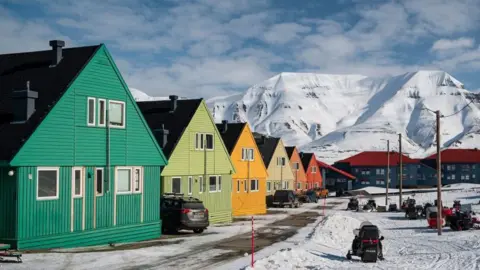### A Unique Data Preservation Initiative in the Arctic
Hidden away within the breathtaking, icy expanse of Svalbard, which is set far above the Arctic Circle, lies a remarkable establishment known as the Arctic World Archive (AWA). Situated just outside of Longyearbyen, the world’s northernmost town, this archive is not merely a repository but rather a vault dedicated to preserving vital cultural and historical data in the face of ever-evolving technology.
At the heart of the archive’s mission is the commitment to ensure that valuable information withstands the test of time, obsolescence, and environmental challenges. Founded by Rune Bjerkestrand, AWA is housed within a decommissioned coal mine and operates under a philosophy that prioritizes the longevity of digital heritage over fleeting technological trends. “This is a place to make sure that information survives technology obsolescence, time and ageing. That’s our mission,” Bjerkestrand states as he guides visitors through the facility.
### The Vault Experience
Entranced by the sheer remoteness of the location, visitors are led along dark passageways illuminated by head-torches, traversing an impressive 300 meters into the mountainside until they arrive at the vault’s imposing metal door. Inside, unique silver packets await—these containers house reels of film, each encapsulating various forms of data that span artistic creations, cinematic works, literature, and more. “It’s a lot of memories, a lot of heritage,” reflects Bjerkestrand as he emphasizes the rich diversity of the materials stored within.
In its relatively brief history since its inception eight years ago, the AWA has witnessed over a hundred deposits from institutions, corporations, and individuals encompassing more than 30 nations. Among these precious items are intricate 3D scans of the Taj Mahal, ancient manuscripts borrowed from the Vatican Library, satellite imagery of Earth, and the iconic painting “The Scream” by Edvard Munch.
### A Safe Haven for Data
The AWA distinguishes itself with its reliance on advanced technology supplied by Piql, a Norwegian data preservation firm which Bjerkestrand also oversees. This initiative was inspired by the nearby Global Seed Vault—a facility designed to conserve seeds from around the globe to replenish food supplies after natural disasters or calamities. “Today, there are a lot of risks to information and data,” states Bjerkestrand, highlighting threats ranging from cyber warfare to terrorism.
Given its geographical location, Svalbard is viewed as an exceptional choice for safeguarding data. Bjerkestrand asserts, “It’s far away from everything! Far away from wars, crisis, terrorism, disasters. What could be safer!” The vault benefits from naturally cold temperatures, maintaining a sub-zero climate essential for preserving film data for centuries. He confidently suggests that even if global warming were to thaw the thick Arctic permafrost, the robust interior of the vault would still effectively shelter its invaluable contents.
### Coding for the Future
Additionally, at the back of this vast vault rests a significant collection known as GitHub’s Code Vault. This project preserves extensive open-source code written by developers worldwide, a critical body of work underpinning various software systems, applications, and websites. Kyle Daigle, GitHub’s chief operating officer, emphasizes the importance of securing humanity’s software future in an age where digital tools are integral to everyday life.
Work by Piql facilitates encoding data files onto photosensitive film, converting complex digital sequences into visually represented images. Senior product developer Alexey Mantsev demonstrates the simplicity of scanning this film later for retrieval, ensuring the content remains permanently accessible despite technical changes over time. Moreover, future generations will receive printed guides upon the film to aid in interpreting and accessing this preserved data.
### A Collective Effort for Cultural Legacy
As the AWA receives deposits thrice yearly, the facility continually grows in its offerings. Recent contributions have included recordings of endangered languages and significant manuscripts like those by composer Chopin. Photographers and archivists alike, such as Christian Clauwers, have entrusted their works to the AWA, reinforcing its role in documenting vulnerable aspects of culture amidst the present environmental crises.
The challenges faced in persistence underscore the vital nature of initiatives like the AWA. As generations evolve, so too do the formats and technologies we rely upon, leading to concerns over a potential “digital dark age.” Yet projects like the Arctic World Archive aim to bridge that gap, preserving culture and information for decades—and possibly centuries—to come.



